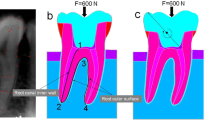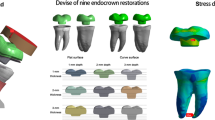Abstract
The aim of this finite element method (FEM) study was to test two different restorative techniques used for construction of severely damaged endodontically treated premolar teeth using Finite Element Stress Analysis Method. In this study, four types of three-dimensional (3-D) FEM mathematical models simulating (1) a sound lower single rooted premolar tooth with supporting structures; (2) a root-filled lower premolar tooth without lingual cusp, restored with resin composite; (3) a root-filled lower premolar tooth without lingual cusp restored with resin composite in combination with a polyethylene fiber which is placed circumferentially to help to create a composite lingual wall; (4) a root-filled lower premolar tooth without lingual cusp restored with resin composite in combination with a glass fiber post, were modeled. A 300-N static vertical occlusal load was applied on the node at the center of occlusal surface of the tooth to calculate stress distributions. Solidworks/Cosmosworks structural analysis programs were used for FEM analysis. The analysis of the von Mises stress values revealed that maximum stress concentrations were located at loading areas for all models. Root dentine tissue, lingual cortical bone, and apical bone structures were other stress concentration regions. There were stress concentration differences among the models at root dentine tissue. Although the distribution pattern was similar with composite resin restored tooth model, highest stress values were observed at root dentine in the model restored with post-and-core. Post structure accumulated more stress on its own body. Stress distribution patterns of sound tooth and fiber-reinforced restoration models were found as similar. The present study showed that the use of post material increased the stress values at root dentine structure while reinforcing the restoration with a fiber decreases stress transmission. Fiber-reinforced restoration provided stress distributions similar to sound tooth.






Similar content being viewed by others
References
Ausiello P, Apicella A, Davidson CL (2002) Effect of adhesive layer properties on stress distribution in composite restorations—a 3D finite element analysis. Dent Mater 18:295–303
Beer FP, Johnston R (1993) Chapter 6: transformations of stress and strain, mechanics of materials. 2nd SI Metric ed. McGraw-Hill, Singapore, pp 367–369
Belli S, Cobankara FK, Eraslan O, Eskitascioglu G, Karbhari V (2006) The effect of fiber insertion on fracture resistance of endodontically treated molars with MOD cavity and reattached fractured lingual cusps. J Biomed Mater Res B Appl Biomater 79:35–41
Kishen A (2006) Mechanisms and risk factors for fracture predilection in endodontically treated teeth. Endodontic Topics 13:57–83
Friedman CM, Sandrik JL, Heuer MA, Rapp GW (1975) Composition and mechanical properties of gutta-percha endodontic points. J Dent Res 54:921–925
Assif D, Bitenski A, Pilo R, Oren E (1993) Effect of post design on resistance fracture of endodontically treated teeth with complete crowns. J Prosthet Dent 69:36–40
Bergman B, Lunquist P, Sjogren U, Sundquist G (1989) Restorative and endodontic results after treatment with cast post and cores. J Prosthet Dent 61:10–15
Fredriksson M, Astback J, Pamenus M, Arvidson K (1998) A retrospective study of 236 patients with teeth restored by carbon fiber reinforced epoxy resin posts. J Prosthet Dent 80:151–157
Qualtrough AJE, Mannocci F (2003) Tooth-colored post systems: a review. Oper Dent 28:86–91
Deliperi S, Bardwell DN, Coiana C (2005) Reconstruction of devital teeth using direct fiber-reinforced composite resins: a case report. J Adhes Dent 7:165–171
Deliperi S. Direct fiber-reinforced composite restoration in an endodontically treated molar: a three year case report. Oper Dent 2008; Mar–Apr; 33(2):209–214
Asmussen E, Peutzfeldt A, Sahafi A (2005) Finite element analysis of stresses in endodontically treated, dowel-restored teeth. J Prosthet Dent 94:321–329
Chen J, Xu L (1994) A finite element analysis of the human temporomandibular joint. J Biomech Eng 116:401–407
Eskitascioglu G, Usumez A, Sevimay M, Soykan E, Unsal E (2004) The influence of occlusal loading location on stresses transferred to implant-supported prostheses and supporting bone: a three-dimensional finite element study. J Prosthet Dent 91:144–150
Magne P, Perakis N (2002) Stress distribution of inlay-anchored adhesive fixed partial dentures: a finite element analysis of the influence of restorative materials and abutment preparation design. J Prosthet Dent 87:516–527
Magne P, Versluis A, Douglas WH (1999) Rationalization of incisor shape: experimental–numerical analysis. J Prosthet Dent 81:345–355
Wheeler RC (2003) Wheeler’s dental anatomy, physiology, and occlusion, 8th edn. Saunders, St. Louis, p 154
Tada S, Stegaroiu R, Kitamurs E, Miyakawa O, Kusakari H (2003) Influence of implant design and bone quality on stress/ strain distribution in bone around implants: a 3-dimensional finite element analysis. Int J Oral Maxillofac Implants 18:357–368
Belli S, Eskitaşcioglu G, Eraslan O, Senawongse P, Tagami J (2005) Effect of hybrid layer on stress distribution in a premolar tooth restored with composite or ceramic inlay: an FEM study. J Biomed Mater Res B Appl Biomater 74:665–668
Eskitascioglu G, Belli S, Kalkan M (2002) Evaluation of two post core systems using two different methods (fracture strength test and a finite elemental stress analysis). J Endod 28:629–633
Weinstein AM, Klawitter JJ, Cook SD (1980) Implant-bone interface characteristic of bioglass dental implants. J Biomed Mater Res 14:23–29
Yettram AL, Wright KW, Houston WJ (1977) Centre of rotation of a maxillary central incisor under orthodontic loading. Br J Orthod 4:23–27
Beer FP, DeWolf JT, Johnston ER (2005) Mechanics of materials, 4th edn. McGraw-Hill, Singapore, pp 360–378
Pegoretti A, Fambri L, Zappini G, Bianchetti M (2002) Finite element analysis of a glass fibre reinforced composite endodontic post. Biomaterials 23:2667–2682
Timoshenko S, Young DH (1968) Elements of strength of materials, 5th edn. Wadsworth, Florence, p 377
Ugural AC, Fenster SK (2003) Advanced strength and applied elasticity, 4th edn. Prentice-Hall, New York, pp 155–157
Yang HS, Lang LA, Molina A, Felton DA (2001) The effects of dowel design and load direction on dowel-and-core restorations. J Prosthet Dent 85:558–567
Belli S, Erdemir A, Ozcopur M, Eskitascioglu G (2005) The effect of fibre insertion on fracture resistance of root filled molar teeth with MOD restorations restored with composite. Int Endod J 38:73–80
Belli S, Erdemir A, Yildirim C (2006) Reinforcement effect of polyethylene fibre in root-filled teeth: comparison of two restoration techniques. Int Endod J 39:136–142
Meiers JC, Kazemi RB, Donadio M (2003) The influence of fiber reinforcement of composites on shear bond strengths to enamel. J Prosthet Dent 89:388–393
Belli S, Dönmez N, Eskitascioglu G (2006) Effect of c-factor, fiber or flowable resin on dentin bonding. J Adhes Dent 8:247–253
Ko CC, Chu CS, Chung KH, Lee MC (1992) Effects of posts on dentin stress distribution in pulpless teeth. J Prosthet Dent 68:421–427
Pierrisnard L, Bohin F, Renault P, Barquins M (2002) Corono-radicular reconstruction of pulpless teeth: a mechanical study using finite element analysis. J Prosthet Dent 88:442–448
Conflict of interest statement
This study is funded by Research Projects Council of University of Selcuk. The authors declare that they have no financial, professional or other personal interest that could influence the position presented in the paper.
Author information
Authors and Affiliations
Corresponding author
Rights and permissions
About this article
Cite this article
Eraslan, Ö., Eraslan, O., Eskitaşcıoğlu, G. et al. Conservative restoration of severely damaged endodontically treated premolar teeth: a FEM study. Clin Oral Invest 15, 403–408 (2011). https://doi.org/10.1007/s00784-010-0397-7
Received:
Accepted:
Published:
Issue Date:
DOI: https://doi.org/10.1007/s00784-010-0397-7




